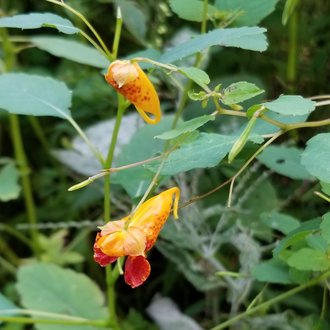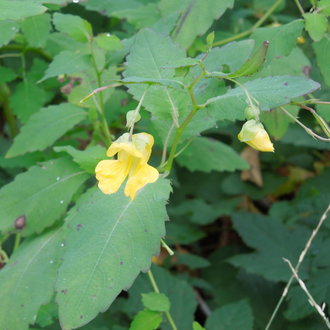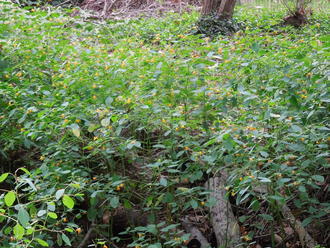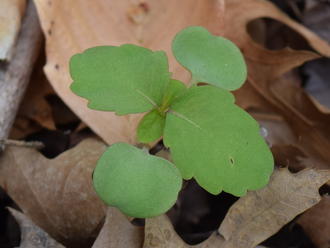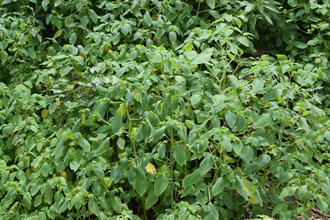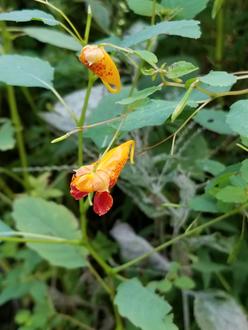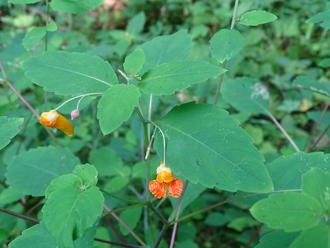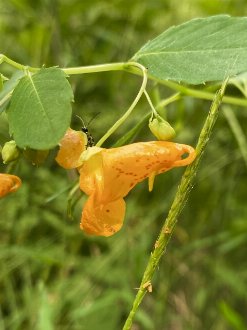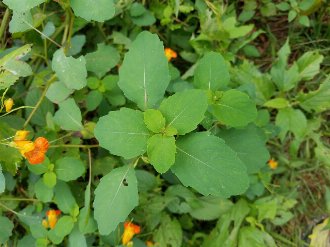Jewelweed (Impatiens capensis Meerb.)
Also known as spotted touch-me-not.
↑Summary
An annual of wet areas, native to North America.
↑Range - Expand
| Legend | Color |
| Native | |
| Introduced | |
| Native or Not Present | |
| Introduced or Not Present | |
| Native or Introduced |
This tentative map is based on our own research. It may have limited data on Canada and/or Mexico, and there is some subjectivity in our assignment of plants as introduced vs. expanded. Read more in this blog post.
Although this plant occurs somewhere in each of these regions, it may only occur in a small part of some or all of them.
↑Similar Plants
↑Habitat
Found in moist to wet conditions in light shade to partial sun. Occurs in moist, open areas in woodlands, floodplains, and partly-shaded areas of wetlands, seeps and ditches along roadsides. Common in much of its range. Occasionally found on locally-moist sites in mesic upland forests, especially when such sites have been disturbed in such a way that increases light levels.
Growth is more limited by moisture conditions than anything else; plants tolerate prolonged flooding, including up to two weeks of standing water completely covering the root system, and they can grow on moist ground as well. Their drought tolerance is poor and plants will die quickly if the soil they are rooted in dries out.
Jewelweed tolerates a wide range of soil pH, but prefers soils rich in organic matter, usually decaying leaf litter. It is largely indifferent to the underlying substrate in soil, and can be found on areas with sandy, clayey, or rocky substrates so long as there is sufficient organic matter and water.
Jewelweed has a narrower range of preferred lighting conditions, requiring some direct sunlight, either a few hours of unshaded, direct sunlight, or dappled sunlight through an open canopy, but it is uncommon in full sun exposures. In full-sun wetlands it is usually replaced by plants that either tolerate longer periods of standing water (if water levels are stable) or better tolerate drought (if water levels vary.)
As an annual, the relative abundance of this plant vary from year to year dependent on weather patterns. In years with consistently high rainfall it can move onto more mesic sites, whereas on drier years it can sometimes temporarily colonize portions of wetlands that are more deeply-flooded in a typical year. It also responds to disturbance; in bottomland forests it frequently colonizes gaps with temporarily increased lighting conditions.
↑Life Cycle
Germinates mid to late spring into early summer, and starts growing upright as soon as it sprouts. Begins blooming mid-summer and often continues to bloom. Rather than blooming all at once, this plant opens a few flowers at once, and then starts producing seeds incrementally while opening new flowers. If warm conditions persist longer in autumn, it will continue flowering and producing seeds longer. Towards the end of its life cycle, in fall, it produces non-opening, self-pollinating (cleistogamous) flowers that are inconspicuous. This allows this species to continue producing seeds late in the season as temperatures fall and pollinators are less abundant or absent.
Seeds are spring-loaded and are ejected mechanically from seed pods when ripe.
Plants are killed by frost and this species' seed production is thus sensitive to early frost.
All stages of this plant are sensitive to moisture conditions. In a dry year, plants on drier ground will die and only those in wetlands or the wettest conditions will survive to maturity. In a consistently wet year, this plant will be able to survive on slightly drier ground. Although it tolerates significant standing water, excessive flooding can stunt its growth or kill plants.
↑Faunal Associations
Flowers attract both hummingbirds and bees, especially bumblebees, and less commonly, swallowtail butterflies. This species is of particular importance to hummingbirds since it tends to have a long bloom period that continues up until the first frost, and since it tends to form large colonies, thus providing a consistent nectar source throughout the growing season. Although most pollinators primarily seek nectar, some bees visiting the flowers also collect pollen.
The seeds are eaten by larger birds.
↑Related Plants
Much of its range overlaps with Pale Touch-me-not (Impatiens pallida), which is less common but able to grow on slightly drier ground.
↑Links & External Resources
• Impatiens capensis (Orange Jewelweed) | Illinois Wildflowers (About This Site)
• Impatiens capensis (Jewelweed) | USDA PLANTS Database (About This Site)
• Impatiens capensis | Go Botany (About This Site)
• Impatiens capensis (Jewelweed) | Missouri Botanical Garden Plant Finder (About This Site)
• Impatiens capensis | Biota of North America Project (BONAP) (About This Site)
• Impatiens capensis | NatureServe Explorer (About This Site)
• Impatiens capensis | Missouri Plants (About This Site)
• Orange Jewelweed | Maryland Biodiversity Project (About This Site)
• Impatiens capensis (Spotted Touch-me-not) | Minnesota Wildflowers (About This Site)
• Impatiens capensis Meerburg (Orange Jewelweed, Spotted Jewelweed) | Digital Atlas of the Virginia Flora (About This Site)



